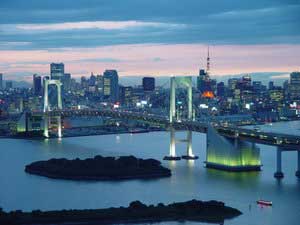By By Brian Bohl
There are very few cities in the world that encompass the politics, finance, education, mass media and pop culture of a country. For the 15 participants of the University’s summer study abroad program in Japan, Tokyo provided a perspective into the Eastern culture and a glimpse into what life is like in a foreign metropolis.
The center of Japan since 1603, Tokyo alone accounts for over 10 percent of the nation’s population. The students had a chance to experience the traditional tourist attractions, while also emersing themselves in the city’s nightlife and culture.
“There are certain cultural etiquettes that you will never ever see here in the United States,” Jennifer Davis, a senior political science major, said. “When entering a restaurant the whole entire crew will welcome you into the place by yelling out ‘welcome to our restaurant’ and as you are leaving will yell out ‘thank you’ in Japanese.”
Even though half of the program took place in Tokyo, the trip also made stops at other major cities in the Land of the Rising Sun. Some of the highlights included visiting the Toyota Factory and the World Expo, which exhibited advancements in technology and demonstrated what robotics will be able to do in the future.
“We stayed two weeks in Tokyo and had many guest speakers,” Dr. Takashi Kanatsu, a professor in the political science department, said. “We went to Hiroshima, Kyoto, and various other cities as well.”
The trip to Hiroshima, one of two Japanese cities that incurred atomic bombings during World War II, provided the most solemn moment of the program. The Hiroshima Peace Memorial Museum showed exhibits about the history of the city before and after the bombing, while also containing artifacts belonging to victims along with vivid pictures that show the destructive power of atomic bombs.
“The atomic bomb museum was one of the most impressive sights for many of our students,” Kanatsu said.
On a more positive note, the program stopped at many of the smaller cities, allowing the splendor and history of Japan’s rich history to be appreciated on a personal level.
“We visited certain sights that clearly represented ancient Japan, such as the Himeji Castle, which was a really beautiful castle made out of wood,” Davis said. “The Takayama village seemed like it was drawn out of a fairy tale.”
Participating in the cultural activities was just as rewarding as visiting the historic sites, said Dr. Patricia Welch, a professor in the comparative literature and languages department.
“We wanted students to have the opportunity to experience the summer festivals and the cultural elements of northern Japan,” she said. “We took part in the Nebuta Matsuri, which is one of the three most famous festivals in all of Japan.”
Kanatsu said a personal highlight for him was talking to members of the conservative Japanese Liberal Democratic Party, the largest political party in the country. The interaction with political leaders allowed the program participants to hear about international affairs from a unique angle.
“We had a meeting with a very prominent Japanese politician who might be a future candidate for Prime Minister,” Davis said. “He discussed certain topics dealing with problems such as China and North Korea.”
The cultural adjustment took time, but Davis said it was not insurmountable. Despite the differences in things like fashion taste, the public transportation and the friendliness of the people made getting around easier.
“The Japanese trains are always, and I mean always, on time,” Davis said. “The people were always willing to help you look for directions even if they did not know any English.”


The night skyline of Tokyo. (Brian Bohl/The Chronicle)

